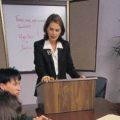Make Sure Your Sales Prospects “Hear” You
I was recently reminded that people take in information in different ways.
This has a critical impact on sales conversations you are having with sales prospects.
Have you ever been in a position where you have been trying to explain to a sales prospect how your service or product could really help them, laying out all the benefits in the way you should – and their eyes glaze over? If you have, you will know that sinking feeling that you are losing them, no matter how well you prepared your pitch, nor how well you got on with them and how you warmed them up at the beginning.
The fact that people have different preferences on how they receive information is crucial to whether or not they “hear” what you are telling them, so what can you do to make sure you give them information in the way they want it?
I’m not an auditory person. This means that if you simply talk to me about your product, as keen as I am to know more about it, I start to lose you when you continue to give me verbal explanations about the product, especially if that verbal communication is full of important facts and figures.
I prefer to see the facts and then take some time to think them through.
On the other hand, others can take in auditory information really well and are able to make decisions based on a conversation, and able to exchange questions and clarification before doing so.
So, don’t sell to me over the telephone. If I am a warm contact, come to meet me and bring brochures and data I can take away. If I am a cold contact, find a way to pique my interest and then send me the information I can read with a simple call to action to find out more.
The different ways people like to receive information, communicate and make decisions are called modalities.
The four modalities are: –
- Auditory;
- Visual;
- Kinesthetic; and
- Logical.
Auditory people like to listen and learn from verbal discussion and exchange. They remember things they hear and can think through the information through a verbal exchange. These people seem to make snap decisions to others, but in reality, they have heard the arguments and have been able to process them by listening. They often use phrases like “sounds good”‘ “I hear you”, “rings a bell”, or “tell me.”
Visual people like pictures, graphs, and videos. They want to “see” how things fit together and often want the bigger picture. Often they doodle as you talk to them or may flick through a brochure looking at subtitles and pictures. When they talk to you they may draw up diagrams on a whiteboard. They use phrases like “I see”, “looks good”, and “show me.”
Kinesthetic people learn through physically moving through the concepts. They like to watch how a process develops so if you are selling something to them they want to see the product or service in action to see how it works. If you are teaching them, they best learn by doing the action themselves; they like to walk through and practice. You’ll hear them say things like “I feel,” or “I’m touched”, or “I can grasp the idea.”
Logical people combine the traits of some of the other types of modalities, combining any two or all of them. They take some information in through listening (when they may get attracted to an idea) but when they want to know more, you will have to move to a different modality to give them information and satisfaction. They like to play with and study data and perhaps explain things in their own words or create their own processes to make sure they understand. They may use a combination of all the phrases of the other types but will also use phrases like “I sense”, “I understand”, “I think”.
Let me be clear, no modality is better than another!
In my own example, if I take longer to decide, it may mean that you have not provided information to me to meet my modality – not that I am a cold-contact or that I can’t make decisions! If you recognise that, you can stop hammering me with a modality that does not work and move to one that does.
In a more general sales presentation where you may be communicating to a larger group, you may have to build in all modalities!
In my online training products created for a variety of consumers, I provide the learning in different ways – I provide an instructional video and downloadable reading. I may also mix it up with step by step slideshows on how to do something and include worksheets you can work through yourself, as well as auditory instructions.
When you present to a larger group, you may have to prepare a speech, provide a slideshow, and make available fact sheets and brochures.
The important thing is that when you are providing information to someone, don’t give them the modality that you feel comfortable with. Learn to recognise how the person you are speaking to likes to receive information and match their modality, then watch your sales conversion rates soar.
If you want to know more about sales and marketing, and indeed receive tools and ideas on how to grow your business in other ways, go to teikoh.com where I give you plenty of free tools and processes to create winning strategies.
While you’re there, please register to get these valuable tips and techniques sent to you directly to your inbox.
And please don’t worry – I hate spam as much as you do and will never share your details with someone else! If you ever want to stop hearing from me, my emails have a simple one-click unsubscribe button (but I hope you never get there!)
See you next week.






No comments yet.
Add your comment